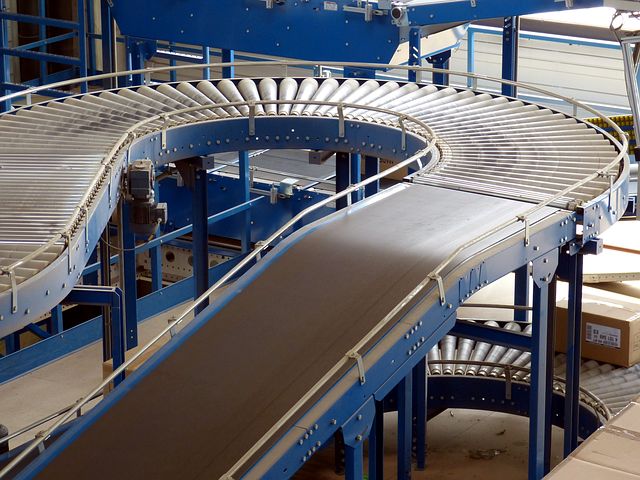Section 1, Preparation before splicing.
- SETTING UP THE SPLICING AREA in complicate construction environment.
It is easier to splice on a horizontal portion of the conveyor belt than it is on an incline. If it must be done on an incline, work at the lower end of the conveyor belt where the operation will be easier to perform.
Some shelter should be provided to keep the work area dry and clean enough. A permanent structure or a temporary enclosure is the usual form of protection. This shelter will bring many convenience for the workers operation especially in difficult construction environment such as with large wind or dust. Therefore this is very necessary, can help the next splicing job finished quickly.
After removing 7m to 9m of conveyor idlers, set up a table at the splicing site with access to the work from both sides of the conveyor. If necessary, erect platforms in the splicing site to make the work accessible. Where the conveyor is too high to set up a splicing table, and more than one splice is required, a splicing table can be set up on the ground, in line with the conveyor. As each splice is completed the belt can be run onto this conveyor. Of course, the final splice will have to be made somewhere on the conveyor itself because at last the conveyor is not long enough to make on the ground.
If logistics call for installing several belts at one point and splicing them at another point, sections can be joined with mechanical splices such as belt fastener, rivets fastener, seamless belt joint and pulled through. When the splice reaches the splicing table, remove the mechanical fasteners and splice the other joint sections one by one till the whole conveyor belt running in a ring.
Section 2, start making the conveyor joint splicing.
- CLAMPING
Overlapping belt ends should be tightly clamped so that belt ends will remain firmly in place but no retract. Although clamps can be made out of wood or other materials, plate steel clamps are much more effective because long conveyor belt need high strength clamps. If you have no time or extra money to buy a new specific conveyor belt clamps, you can make this type of clamp by yourself, cut large rectangular pieces of steel to length. Bond pieces of rubber pulley lagging to the side that will contact the belt. Place one clamp 1m to 1.2m from end of the belt. Place the other clamp. 3m to 3.5m from the other end. Secure one clamp to the conveyor frame, then draw the other one to it with chain blocks to tighten the belt. If you have financial support better buy professional belt clamps for the conveyor joint part because can both save your operate time and construction effect. Pull to remove the sag between the return idlers with the takeup pulley in its proper position.
Section 3, start operation.
- PREPARING FOR THE SPLICE
These instructions apply to both mechanical and vulcanized splices.
- Be sure belt joint ends are in good operated states. If they are damage or thin after wear or oil-soaked, cut back until you find a strong, uncontaminated area.
- Draw proper centerlines. They are essential for a good splice.
- The take up pulley should be set to allow for the full amount of expected movement – elongation of the extra conveyor belt after you finished splicing joint, pulley travel in start and stop, and storage of spare belting.
The subject of takeups and takeup travel is covered in other procedures, but here is a helpful tip. If takeup movement cannot be maximized when several vulcanized splices are to be made, use of a mechanical fastener in the final splice to find a right length of the joint part will allow the belt to operate until it has stretched enough for a vulcanized splice to be made.

conveyor belt
Take up arrangement
Section 4, Other conveyor belt splicing methods.
- MECHANICAL SPLICES
Mechanical splices are most often used where takeup movement is limited, or where time does not permit vulcanization, such as belt fastener joint, super screw joint, rivet hinged stapler joint and other special methods to make joint. Although these mechanical joint cannot withstand long conveyor running and have requirements for the conveyor belt thickness, drum size or working environment limits. But in the time urgent or special conveyor lines, the mechanical splices methods are necessary.
- SELECTING THE RIGHT FASTENER
Choosing the right fastener need to consider various factors: Pulley diameter, belt thickness, belt tension, loads, materials carried, startup voltage condition, frequency of starting and stopping. What’s more, different types of fasteners are used for different types of belts. Hook type fasteners are fine for lightweight carcasses, but bolt and rivet-type fasteners are needed for heavier carcasses. Seamless belt joint can be used for fabric belt within 25mm. In high tension applications, plate fasteners often work best. And in underground mining, interchangeable hinge fasteners are preferred. In metal proceed conveyor line which need anti-attractive, the stainless steel will be the better choice.
- INSTALLING FASTENERS
For well-balanced bolt-type splices, start torquing bolts at the center of the splice and work out. To obtain maximum splice efficiencies and to avoid damaging carcass fabrics, know and set torquing limits in advance.
When installation is complete, taper each corner of belt ends to prevent bulging that occurs at the edge of the splice.
There are professional 4 in 1 set of installation tools can easily install by no trained workers very quickly.
Apart from Belt fastener , there are also seamless joint details can be choose.
- MAXIMIZING FASTENER EFFICIENCY
Where either belt cover is greater than 5mm, the cover can be cut away for countersinking fasteners. Stresses on the cover and the fasteners are reduced. When either belt cover is greater than 5mm, the fasteners should be countersunk to allow the fastener teeth deeper penetration into the carcass. Countersinking reduces wear of the fasteners and noise on return idlers.
- MECHANICAL FASTENER PRECAUTIONS
Check mechanical fasteners often for wear or breakage. Where fasteners are missing, the strain on the remaining fasteners may be too great to hold the splice together.
Although a variety of fasteners may seem appropriate for your needs, be sure to check all alternatives before making your selection. Consult fastener manufacturer’s recommendations for the correct fastener for your application. Choose the right size and type as your conveyor belt detailed information.







You must be logged in to post a comment.